Column
Mucha Wuxia
by Mike Toole,
It's a big, bright, hot summer in this year of 2016, and if you're not spending your weekend nights watching Thunderbolt Fantasy, you're missing out. It's proving to be one of the most exciting new anime series of the summer – with storytelling duties by the infamous Gen Urobuchi, a surging, pulsing theme tune by T.M. Revolution, and a large, exciting cast of characters having life-or-death battles with ridiculous magic swords, spears, and arrows, it's no wonder that it's so popular. Also, it's done with puppets. You know, just like The Muppets, and The Great Space Coaster, and Lazy Town.

I knew right away that I wanted to see Thunderbolt Fantasy in spite of its unusual visual style. Actually, it was because of its unusual visual style that I wanted to see it; this show is the latest in a performing tradition called budaixi, the art of puppetry using gloves. While we sit in front of our TVs, straining to see where they'd digitally erased the strings, the characters' sweeping martial arts moves are actually controlled by concealed fingers, which makes it easy for them to do stylish kicks and flips. The reason I wanted to see Thunderbolt Fantasy so badly, aside from its bomb-diggity trailer, was because of an earlier film called Legend of the Sacred Stone.
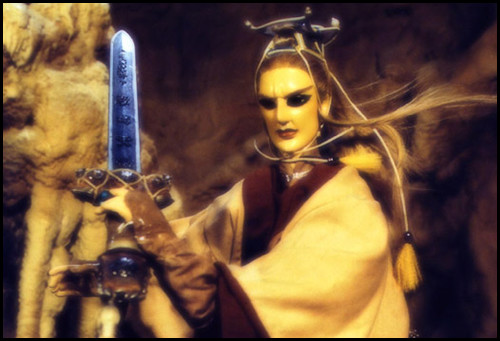
Sacred Stone is pretty similar in look and style to Thunderbolt Fantasy. It's a Taiwanese film from 2000 done with that same budaixi puppetry, concerning the battle over the kingdom of Wulin between a demonic martial arts master and a trio of heroes. The movie is a compressed version of an earlier TV series, and it begins with a jaw-dropping opening fight between the bad guy, Mo Kuai, and the wise master of the heroic trio, Su Huan-Jen. From there, the scale gets bigger and bigger, with pitched battles in bamboo forests, exploding castles, and earth-shaking supernatural combat. The film, which I'm pretty sure I first saw at a buddy's place on VCD with burned-in subtitles (ahh, the good old days), is really entertaining, a movie that successfully conveys an intense sense of awe, wonder, and deep, ingrained campiness. Because after all, these are puppets! The Japanese release even refers to the film's budaixi technique as “hyper-marionation,” a moniker that would later be dusted off by Gerry Anderson's production company for their new CG Captain Scarlet TV series.
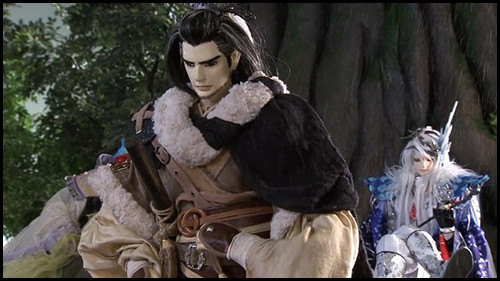
In fact, you might've gotten a taste of Legend of the Sacred Stone yourself, if you spent afternoons in the mid-2000s watching Toonami. The film's predecessor, a TV series called Pili, was adapted for American TV under the title Wulin Warriors. It flopped immediately, for two reasons. First of all, the TV series is kinda boring, which is apparently also part of the budaixi tradition. (A buddy of mine who grew up in Taiwan expressed amazement at Thunderbolt Fantasy, largely because he remembers the budaixi TV shows of his youth boring him to tears.) Secondly, the US producers went for a zany, campy comedy dub, and the results are totally unwatchable. It's incredibly hard to pull off camp deliberately. You need to be completely earnest, and that's a big part of why the formula works in Thunderbolt Fantasy – it toes the line between high camp and epic storytelling.
But if you're enjoying Thunderbolt Fantasy, where should it lead you? Its storytelling is in the tradition of wuxia, a genre of Chinese fiction all about martial arts, battling evil, and righting wrongs. Wuxia is hundreds of years old, but it got a major resurgence in the 20th century courtesy of talented storytellers like Gu Long and Jin Yong (I use their names specifically because they've had work translated into English), writers who published chapters of their stories in popular magazines and newspapers and readily placed the genre's rote, stuffy Confucian tradition asides in order to introduce a greater emphasis on romance and comedy. These days, the storytelling tradition of wuxia drives dozens of novels, comics, films, and cartoons every year.
If you like the Thunderbolt Fantasy, just walk the path of wuxia, and start with the great Hong Kong films of the 60s, 70s, and 80s. Western audiences got their first major exposure to wuxia via Ang Lee's Crouching Tiger, Hidden Dragon, but that movie (which is, make no mistake, damn good) is just following in the footsteps of earlier films like Come Drink with Me, Dragon Inn, and the Brave Archer trilogy. If you specifically enjoy Thunderbolt Fantasy's crazy special attacks, high-flying fighters, and kung-fu secrets, dig up a film called Zu Warriors of Magic Mountain.
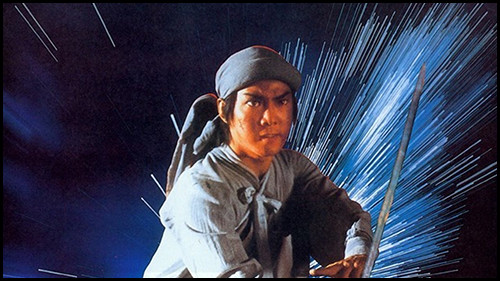
Zu is worth seeing just based on its cinema history credentials – it was a success for its young director Tsui Hark, and an early harbinger of Hong Kong's 80s and 90s cinematic boom. But it's also an eye-popping martial arts epic—stars Sammo Hung and Yuen Biao made some of the greatest kung fu movies ever together, and Zu is one of them! What really makes the film stand out is its blend of eastern special effects, with wire-fu and puppetry, with western-style SFX, featuring extensive use of miniature models, compositing, and cool optical effects. And I really have to harp on this film, because while it drew a large cult audience in decades past, it and films like it not as easy to find as they used to be. Seek it out! After all, you kids are gonna have to learn about the One-Armed Swordsman sooner or later.
What about wuxia anime? Of course there's wuxia anime! There's actually an emerging boomlet of animated shows based on wuxia, but I'll touch on that in a bit. The first anime that was explicitly and specifically based on a modern wuxia epic is Legend of the Condor Hero, a 2001 series created by Nippon Animation. The original Condor Hero starts with two friends, who, at the end of a great war to repel an invasion, swear that their children will team up and save the world. It doesn't turn out that way. One man's son, Guo Jing, learns martial arts from a group of five bizarre masters. The other, Yang Kang, learns deadlier techniques in seclusion. They're destined to come together, but not as allies—as adversaries. Set during a historical period that saw the Mongol invasion, the Condor Hero trilogy is one of Jin Yong's most beloved works, a saga that's been remade again and again for TV, movies, and animation. (Jin Yong himself revised the story a couple of times—a clever way to keep the story fresh, and to keep its fans talking about it.) How does the anime version stack up?
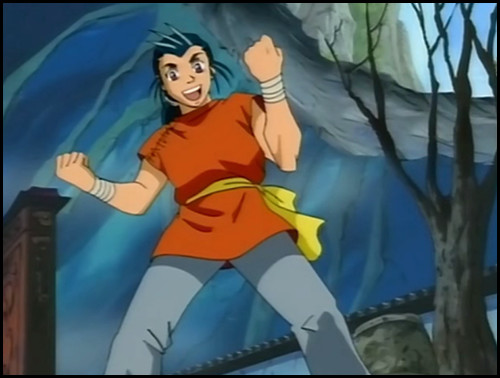
It's interesting, but a wildly mixed bag. Nippon Animation's retelling, done in tandem with Chinese studio Jade Animation, tosses out the fated-rivals angle to tell Guo Jing's story, of how he learns martial arts, falls in love with one of his teachers, and pursues her across the land, fighting bad guys in the period just before the final battle that would see the Song Dynasty yield to the Mongols. Its technical background essentially means that Nippon Animation supplied their Chinese partners with character sheets, storyboards, scripts, layouts, and then just let them run with it. Consequently, the show is a bit stiff and workmanlike, which isn't really helped by the fact that it was made during the transition from cel animation to digital. Still, the show was pretty popular, and its first season was even dubbed in English and released on DVD in North America.
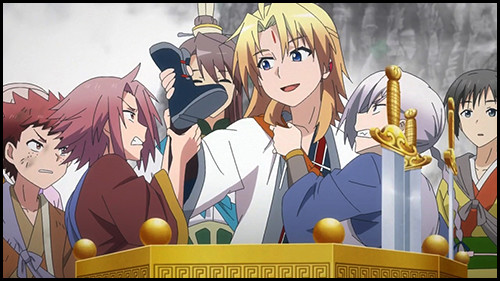
A more recent example of compelling wuxia anime would be Reikenzan, a comedy-adventure TV series by Chinese studio Haoliners and Japanese Studio DEEN. I like this kind of coproduction, which marries Japan's technical expertise with the culture that spawned the source material – in that sense, these productions are a bit like the superhero cartoons that are cooked up in the US, but still animated in Japan. Anyway, Reikenzan is an enjoyably dumb action-adventure about a young hero named Oriku, a traveler who seeks to pass a series of tests in order to join the powerful Reiken clan. Oriku is a fighter without peer, a studious scholar, and a young man with a great and boundless love of talking trash. He easily passes the first exam, which can only be solved by approaching a motormouthed old man and successfully arranging a date for him. The show is a wry, fun little comedy adventure, and I wish it'd get picked up officially so I could see more of it.
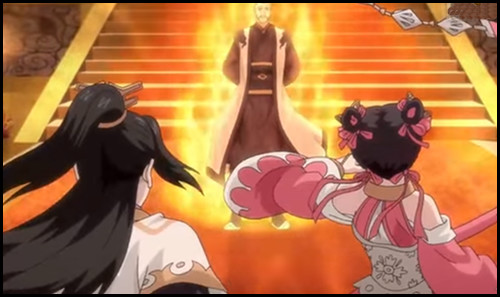
Shows like Reikenzan are the direct product of China's intense hunger for Japanese animation. (What, you think that only the west is voraciously gobbling up every new series on streaming? China's got their own streaming powerhouses, like bilibili, and Alibaba's streaming portal Youku Tudou!) But there's also domestic product that takes cues from anime, like Zen Tian Ji (“Way of Choices”), a recent wuxia epic that leans towards the Condor Hero tradition. It's about two martial arts brothers going on a quest, but what really makes watching it instructive is that it exposes some of the formula used in shows like Thunderbolt Fantasy. In long serialized stories like this, the characters always spend the first bit of the episode making plans and scheming against their adversaries, and then there's a big, bombastic fight scene to tie the episode up, and just enough of a cliffhanger to keep things going. You'll see this formula faithfully repeated across many different wuxia shows, so stick with it—it really works!
Then, there's the ultimate wuxia anime: G-Gundam. If you're a fan of the storytelling tradition's martial arts, admirable values (wuxia is pretty much always about righting wrongs and fighting for justice), and grounding in ancient China, you might roll your eyes a bit, but stop right there! See, there's an extremely famous character in wuxia stories, a powerful and thoughtful fighter called Dongfang Bubai, whose name translates to “the Invincible East.” He's one of Jin Yong's most famous characters, even though he directly appears only fleetingly in the original novel – numerous films, like The East is Red and the Swordsman movies, portray him as a nearly invincible warrior, one who's studied the principles of kung fu to perfection.
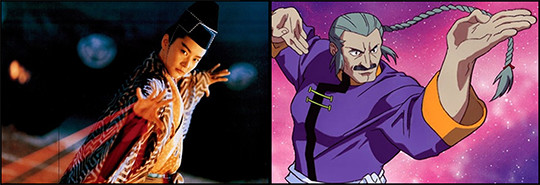
See Master Asia up there on the right? Same character as the one on the left! (That's Brigitte Lin as Dongfang Bubai.) Alright, not exactly the same, but G-Gundam's martial arts mentor is clearly based on the original undefeated master of the East. G-Gundam was written and directed by Yasuhiro Imagawa, a professed fan of wuxia, and the series follows a lot of the genre's beats—a young hero has to master his martial arts, gather allies, and foster a steadfast sense of justice as he rights the wrongs of his enemies. If you specifically prize the sheer camp and utterly sincere over-the-top-ness of Thunderbolt Fantasy, you'll like G-Gundam for the same reasons.
Investigating wuxia is a good idea in general. Doing so has led me to discover that its got subgenres of its own, and that China continues to pump out extremely popular wuxia stories—it's just that, these days, they come from something that the folks call “er ci yuan,” or 2D space. Instead of flashy films, modern wuxia comes out of serialized online novels, comics, and video games. One of the most popular current wuxia tales is I Shall Seal the Heavens, an ongoing illustrated online novel. Its story, about a young man named Meng Hao and his slow rise to power, already spans more than 800 chapters. I'm kinda wondering how much longer we'll have to wait before an anime version is announced.
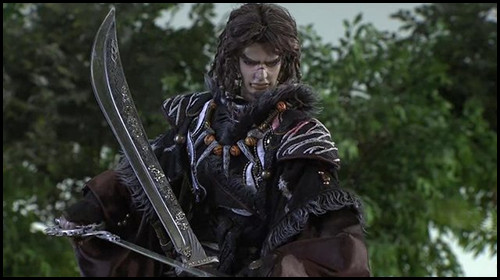
In chasing down some examples of wuxia anime, I was hit over and over again with unfamiliar terminology and surprising character types. Thunderbolt Fantasy, with its massive ensemble cast of likeable and unusual characters (Rogue swordsman? Check. Officious scholar? Check. Scary bad guy with eyepatch? Check. Scornful demon woman? Check.) represents not just an exciting and different spin on the Japanese animation we love, but an opportunity to broaden horizons, and hunt down stories and experiences you might never have investigated otherwise. I'm grateful that its popularity has put the spotlight on wuxia, and hope there's more to come. Are there more wuxia anime worth checking out? Does the genre work better as live-action film, or as budaixi puppetry? Will China's great storytelling tradition and its desire for anime drive the emergence of more great animated wuxia epics? Sound off in the comments!
discuss this in the forum (18 posts) |